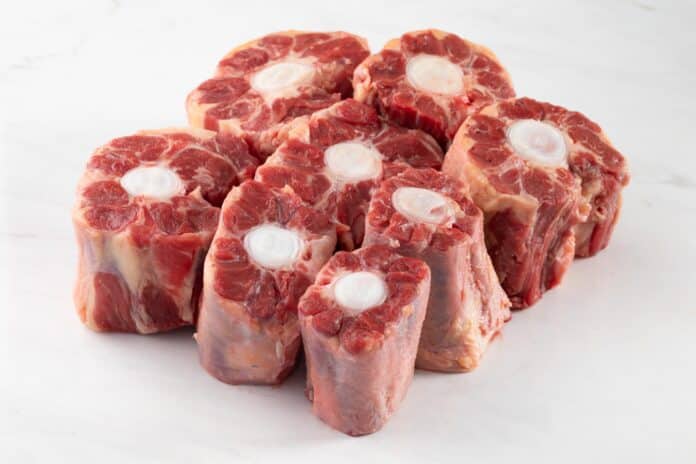What is Oxtail? Oxtail is a cut of meat obtained from cattle and has garnered attention in culinary circles for its distinct taste and texture. Contrary to its name, oxtail is not solely sourced from oxen but is commonly derived from beef cattle.
This article explores the true essence of oxtail, delving into its origins, culinary uses, and unique attributes that have made it a sought-after ingredient in various global cuisines.
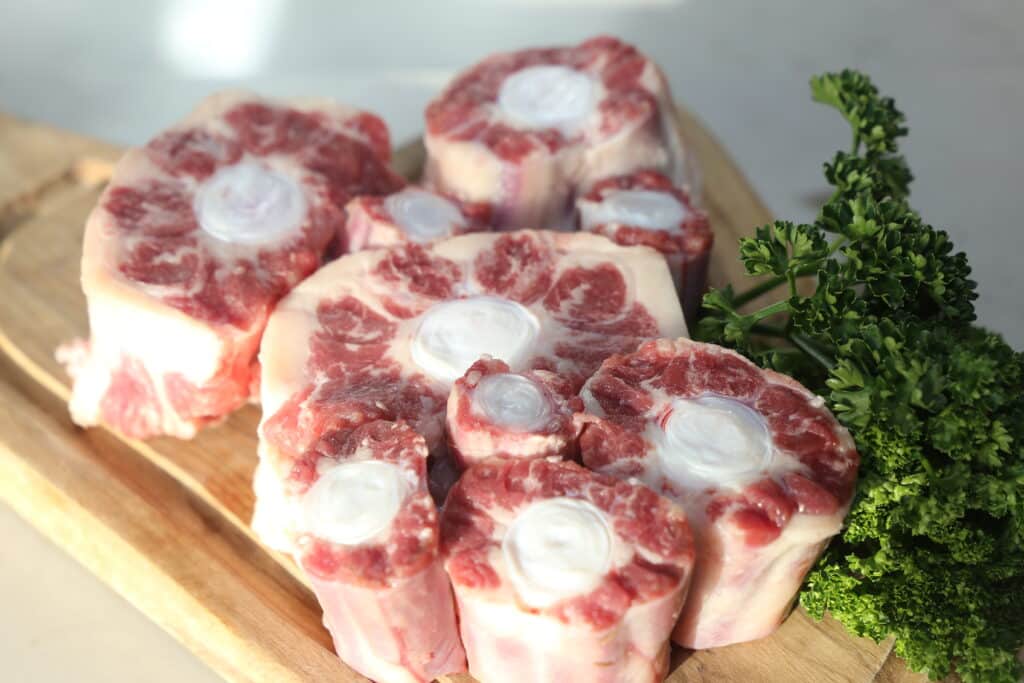
SEE ALSO:
What is Oxtail
Oxtail was a term used to describe the cut of meat taken from the tail of an ox. However, these days its meaning is somewhat broader. It is referred to as the culinary term for the tail of cattle, particularly from adult cattle (oxen) but it can also come from other bovine animals like cows.
The name “oxtail” may be a bit misleading nowadays, as it’s not often sourced specifically from ox but from beef cattle.
Oxtail is a flavorful and gelatin-rich meat that contains a lot of connective tissue. It is tough when cooked quickly. As a result, it’s best suited for slow-cooking methods like braising or stewing. When cooked low and slow, the collagen in the connective tissues breaks down, resulting in tender and succulent meat with a rich, hearty taste.
It’s a popular ingredient in various cuisines around the world, especially in dishes like oxtail soup, oxtail stew, and oxtail ragu. Due to its unique flavour and texture, oxtail has become a sought-after item for those who enjoy hearty and comforting dishes.
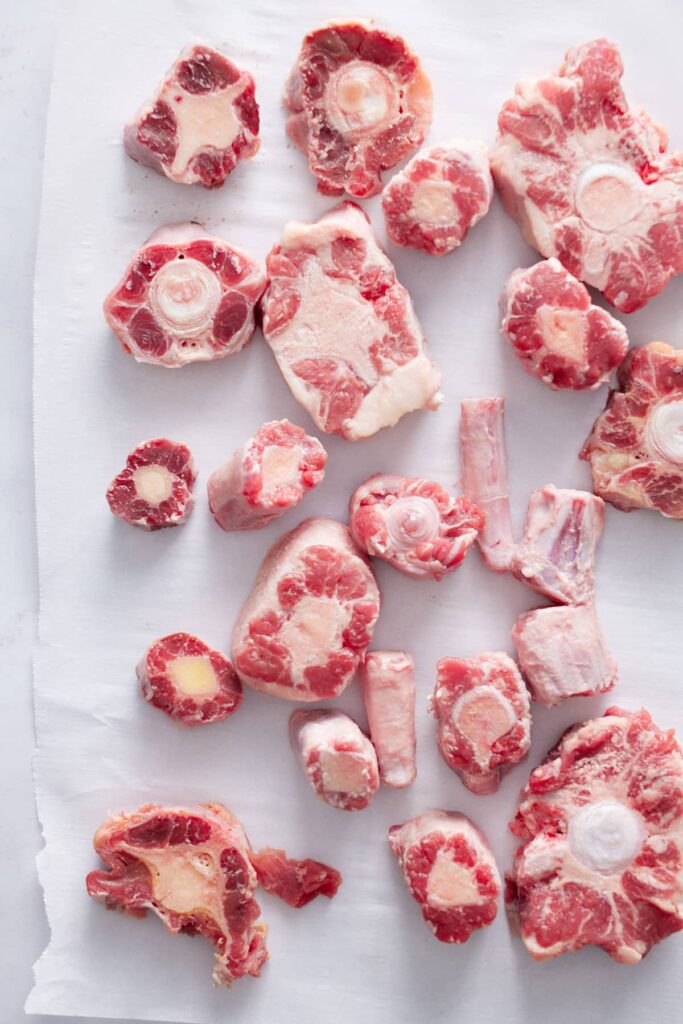
Origin of Oxtail
The consumption of oxtail dates back to ancient times when no part of a slaughtered animal went to waste. Oxtail has been a part of various culinary traditions in different regions throughout history.
The tail contains a large amount of collagen, which makes for gelatine-rich meat with a unique texture that provides a wonderful viscosity to comforting soups and stews.
As the name suggests, oxtail was derived from the tail of oxen, which were used as working animals and as a food source. In many cultures, the use of oxtail in cooking can be traced back to the utilization of the entire animal for sustenance, ensuring minimal waste.
The practice of cooking oxtail became more widespread during the European Middle Ages and Renaissance eras when it was commonly used in stews and soups. The slow-cooking methods used for oxtail made the tough meat tender and flavorful, making it a popular choice among cooks.
Over time, the popularity of oxtail spread to other parts of the world through trade, exploration, and cultural exchanges. Today, oxtail dishes can be found in various cuisines, including European, African, Asian, and Caribbean. It has become a delicacy in many regions, appreciated for its unique taste and texture.
While the traditional use of oxen for labour and food has diminished significantly in modern times, the name “oxtail” has persisted, even when the meat is sourced from regular beef cattle. Despite its historical roots, oxtail remains a beloved and sought-after ingredient in many culinary traditions worldwide.
RELATED ARTICLE: Vegan Tacos Recipe
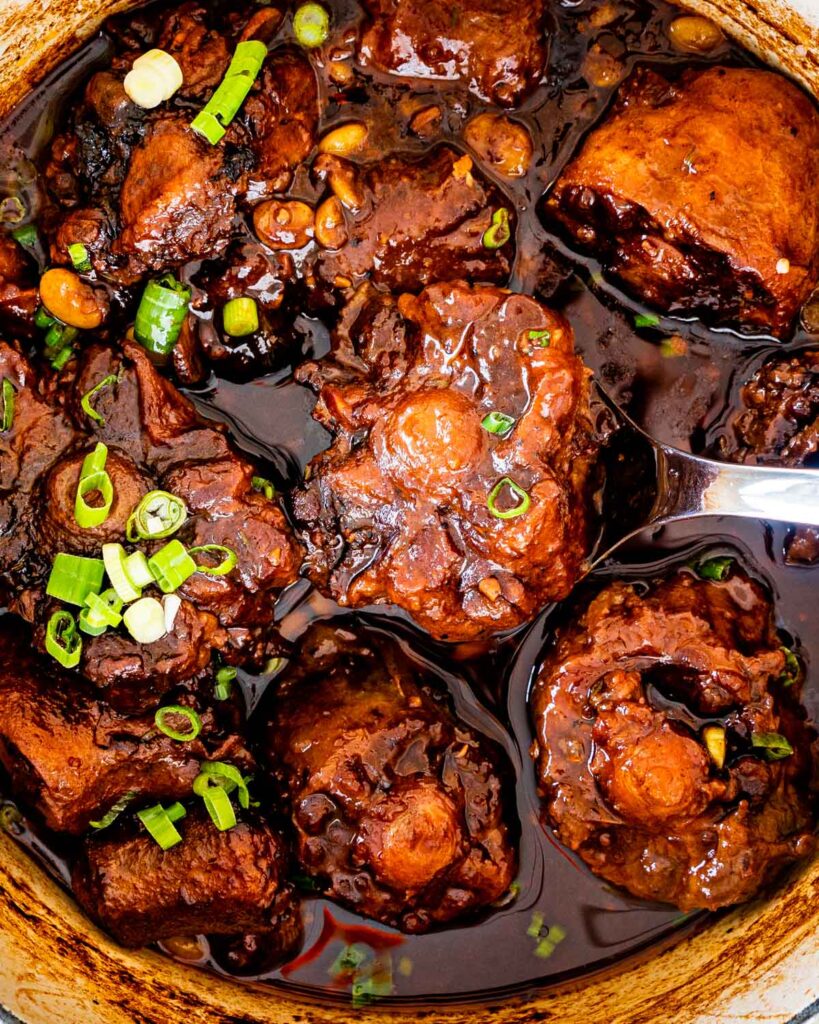
Cooking Techniques for Oxtail
Oxtail is a delicious and flavorful cut of meat, but it requires special cooking techniques to achieve the best results. Due to its tough nature, slow-cooking methods are ideal for tenderizing meat and extracting its rich flavours. Here are some cooking techniques to try.
1. Slow Cooker
Cooking oxtail in a slow cooker is a fool-proof way of tenderizing this cut of meat. The meat and connective tissues are properly broken down through this method to have a melt-in-your-mouth texture. This is the reason why oxtails are mainly braised or used in soups and stews. It’s very rare to see fried or baked renditions.
2. Pressure Cooking
This method may be ideal if you don’t have the time or the patience to slow-cook the meat. By using a pressure cooker to tenderise the beef oxtail, you don’t have to wait overnight to get the best results. Instead, the cooking time is cut down to at least an hour. Just make sure to follow the appliance’s instruction manual, and you’ll be good to go!
3. Stewing
Stewing is similar to braising but involves cutting the oxtail into smaller pieces and fully submerging them in liquid. This technique is often used to make oxtail stews, which can include a variety of vegetables, herbs, and spices. Stewing melds the flavours, creating a hearty and comforting dish.
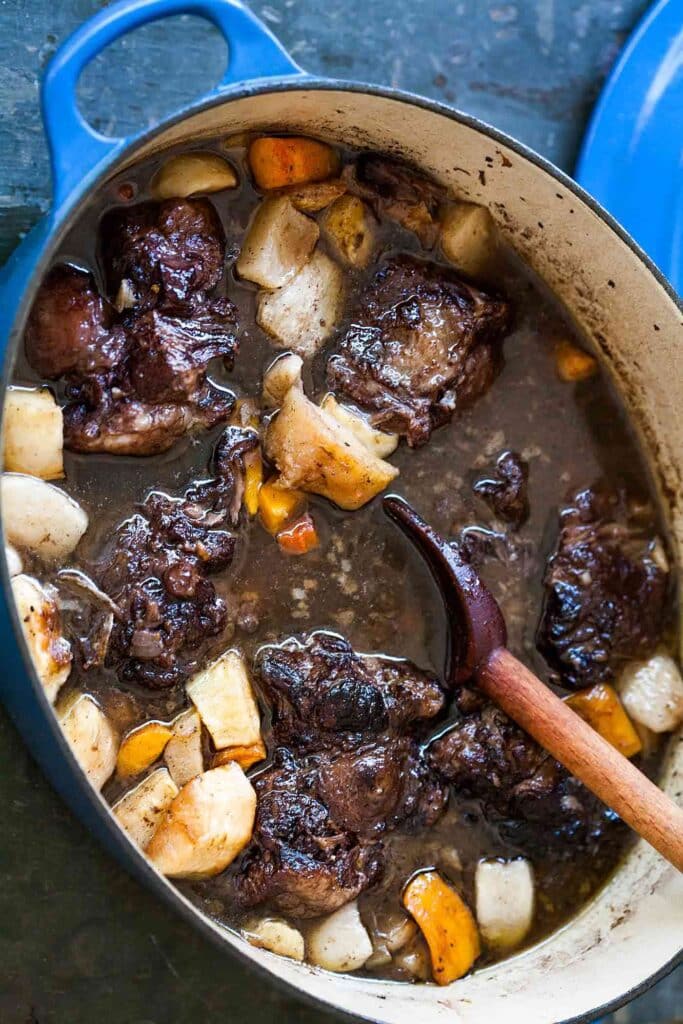
4. Braising
Braising is perhaps the most common and effective way to cook oxtail. First, sear the meat in a hot pan to develop a rich crust to braise oxtail.
Then, transfer the oxtail to a pot or Dutch oven, and add liquid (such as broth, wine, or a combination), vegetables, and herbs. Cover the pot and let it simmer on low heat for several hours until the meat becomes tender and falls off the bone.
5. Grilling
While not as common as the slow-cooking methods, oxtail can be grilled for a unique and delicious preparation. Before grilling, marinate the oxtail to enhance its flavor and tenderness. Grill over medium heat until the meat is cooked through and slightly charred.
SEE: List of Easy Recipes for Picky Eaters
How to prepare Oxtail before cooking
Preparing oxtail before cooking involves a few essential steps to ensure the best results. Here’s a step-by-step guide on how to prepare oxtail:
Purchase fresh oxtail:
Look for fresh oxtail at your local butcher or grocery store. Choose pieces with a good amount of meat on the bones and avoid any with a strong odour or discoloration.
Rinse the oxtail
Before starting any preparation, rinse the oxtail pieces under cold running water to remove any surface impurities or bone fragments.
Pat dry
Use paper towels to pat dry the oxtail pieces. This step helps with searing and browning the meat effectively.
Trim excess fat
While some fat is desirable for flavour, you may want to trim any excessive fat from the oxtail pieces. Leaving a moderate amount of fat can add richness to the dish.
Season the oxtail
Generously season the oxtail with salt and pepper on all sides. You can also add any other desired dry rub or seasoning mix to enhance the flavour.
Sear the oxtail (optional)
Searing the oxtail before braising or stewing can add a depth of flavour to the dish. Heat a large, heavy-bottomed pan over medium-high heat, add a little oil, and sear the oxtail pieces on all sides until they develop a brown crust. This step is optional but highly recommended.
Prepare vegetables and aromatics (if using)
Chop onions, carrots, celery, garlic, and any other vegetables you want to add to the dish. These ingredients will enhance the overall flavour of the oxtail during the cooking process.
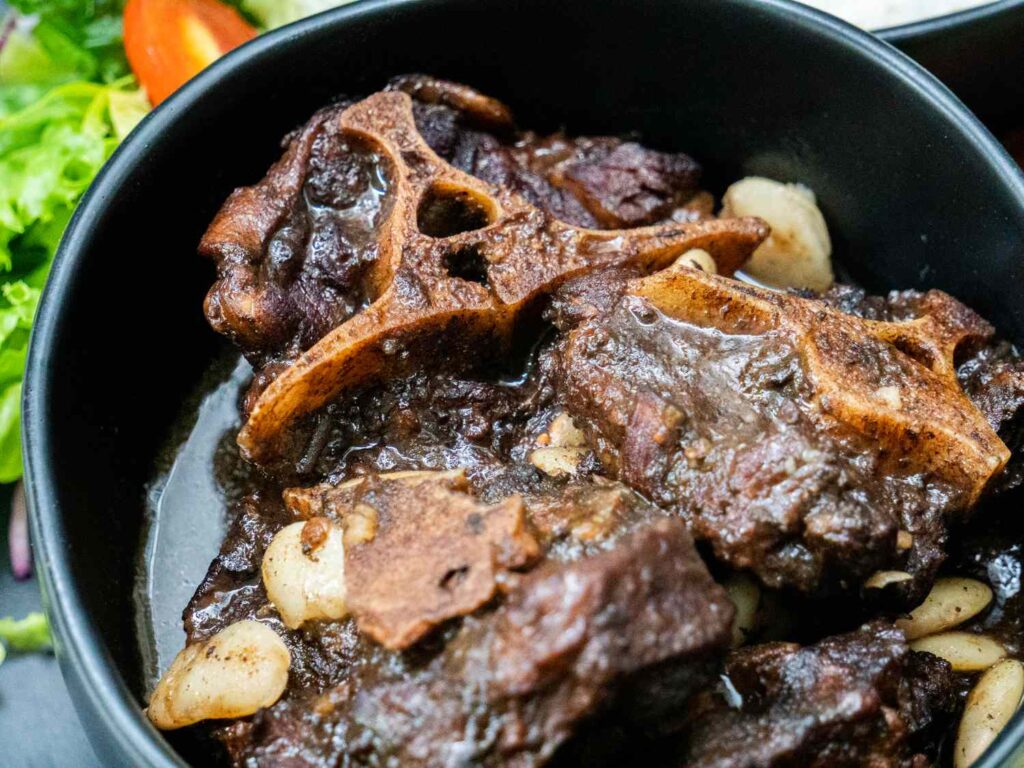
Slow Cooker Oxtail Stew Recipe
Ingredients
- 1 tablespoon vegetable oil
- 3 pounds beef oxtail, cut into pieces
- 1 ½ pounds russet potatoes, peeled and cut into chunks
- 4 carrots, peeled and cut into large chunks
- 3 stalks of celery, cut into large chunks
- 1 onion, chopped
- 1 (15-ounce) can of tomato sauce
- 1 cup beef broth
- ½ cup dry red wine
- 2 tablespoons chopped fresh parsley
- 1 tablespoon Worcestershire sauce
- 1 teaspoon dried thyme
- ½ teaspoon smoked paprika
- 1 (8-ounce) package of sliced mushrooms
- 1 cup frozen peas
- 1 pinch salt and freshly ground black pepper to taste
Instructions
- Heat oil in a large skillet over medium-high heat. Sear oxtail for 4 minutes. Flip and continue cooking until browned on all sides, about 4 minutes. Transfer the oxtail to a slow cooker.
- Add potatoes, carrots, celery, onion, tomato sauce, beef broth, red wine, parsley, Worcestershire sauce, thyme, and paprika.
- Cook on Low for 7 hours. Add mushrooms and peas. Cook for 1 additional hour.
- Ladle into bowls and season with salt and pepper.
SEE: How to make Egg fried Rice: Best Egg Fried Rice Recipes
Braised Oxtail Recipe
Ingredients
- 3 to 4 pounds of oxtail, cut into pieces
- ¼ cup canola oil or other vegetable oil
- 2 to 3 medium onions, diced
- 2 to 3 cloves garlic, crushed
- 1 cup red wine
- 4 cups beef stock
- ¼ cup tomato paste
- 2 to 3 bay leaves
- 1 teaspoon whole black peppercorns
- 1 sprig of fresh rosemary
- 1/4 teaspoon Kosher salt, or to taste
- 1 dash freshly ground black pepper, or to taste
- 1 tablespoon unsalted butter
- 1 tablespoon all-purpose flour
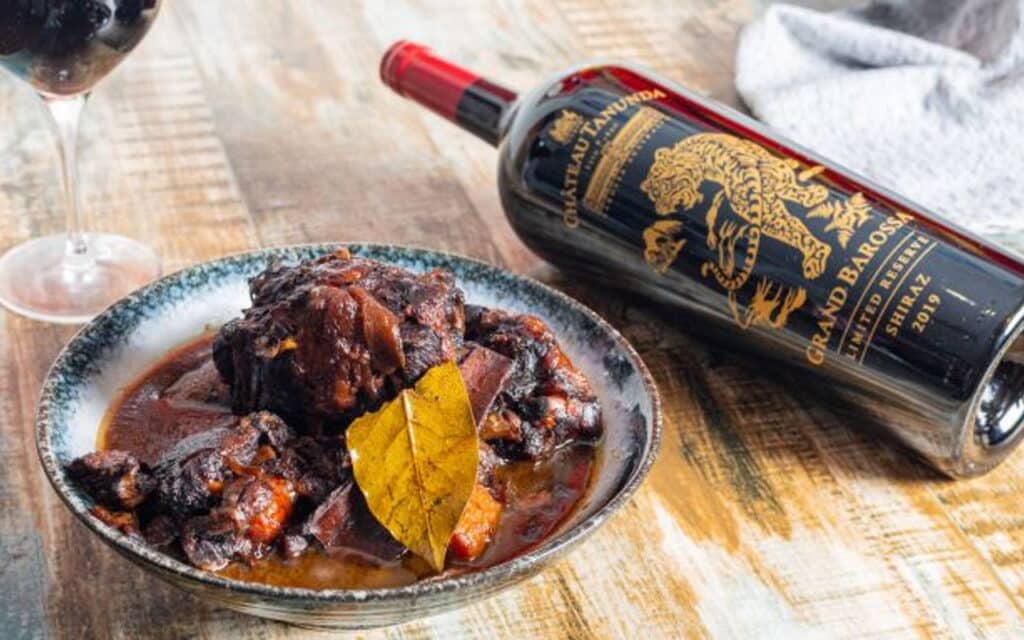
Instructions
- Gather the ingredients.
- Preheat the oven to 300 F. Pat dry the oxtail pieces well with paper towels to help the exterior achieve better browning when searing.
- Heat the oil over high heat in a heavy, cast-iron Dutch oven or brazier. Add the oxtails and sear them thoroughly, turning brown on all sides. Once they’ve developed a nice brown crust, remove the oxtails from the pan and set them aside.
- Lower the heat to medium and add the onions and garlic to the pot. Sauté for 5 minutes or until the onions are slightly translucent.
- Add the wine. Using a wooden spoon or heatproof spatula, scrape all the browned bits from the bottom and sides of the pan.
- Return the oxtails to the pot along with the stock. Add the tomato paste, bay leaves, peppercorns, and rosemary. Season with salt and pepper to taste.
- Bring the heat to high until the liquid boils. Cover with a tight-fitting lid and carefully transfer the pot to the preheated oven. Cook for 3 hours.
- Remove the pot from the oven, take off the lid, and let the meat cool in the braising liquid while preparing the sauce. Ladle out about 2 cups of the braising liquid and pour it through a mesh strainer into a liquid measuring cup. Skim off any fat from the top.
- Heat the butter in a separate saucepan over medium-high heat, then gradually stir in the flour until a paste forms. Heat for a few minutes, stirring until the roux is a light brown colour.
- Whisk the strained hot cooking liquid into the roux a little at a time. Simmer the sauce for about 15 minutes until thickened. Pass it through a fine-mesh strainer to remove any lumps and season to taste with salt and pepper.
- Remove the oxtails from the pot, place them on a deep serving platter or individual plates, and spoon over a generous portion of the sauce. Serve with your favourite sides and enjoy.
Oxtail Recipe Variation
Feel free to pick your most preferred oxtail recipe below
1. Beef Stock
Slow-cooked oxtail turns into beef stock or bone broth for making comfort food items like soup. The end product is a flavorful liquid thicker than regular beef broth.
2. Braised Oxtail Soup
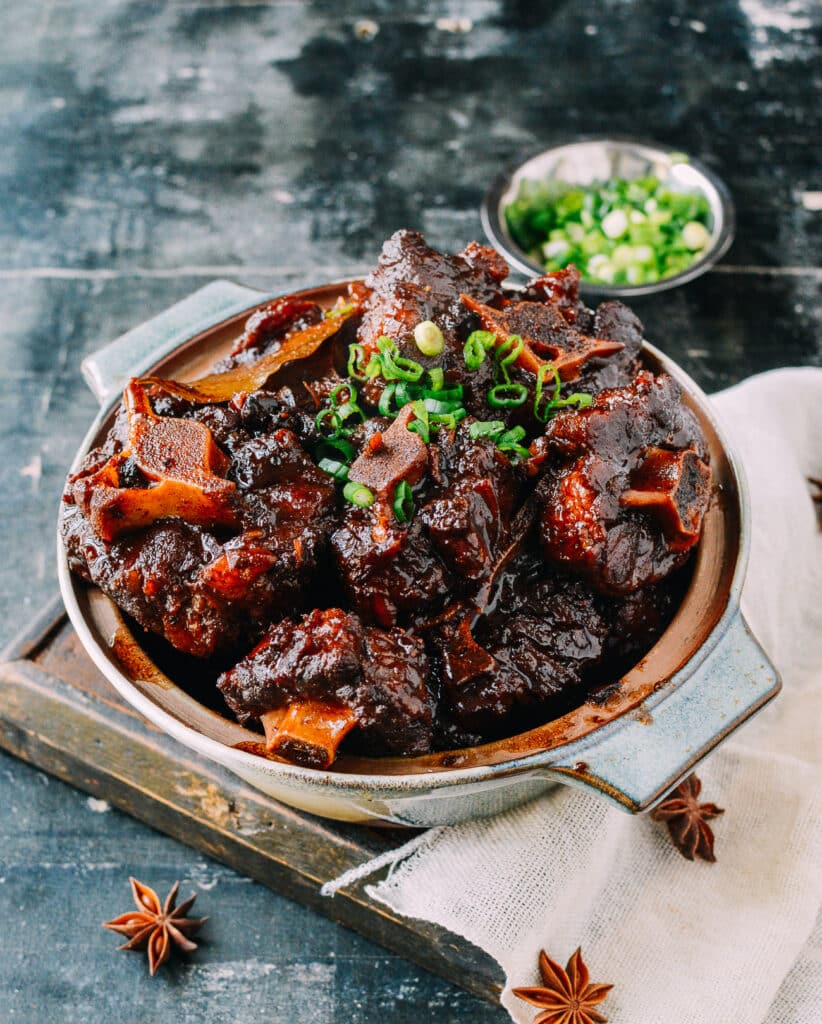
Another broth-based concoction that showcases beef tail as the main ingredient, this braised oxtail soup recipe makes for a hearty meal. The meat pieces are browned in olive oil before simmering. Some renditions may call for apple cider vinegar to balance off the flavours.
3. Jamaican Oxtail Stew
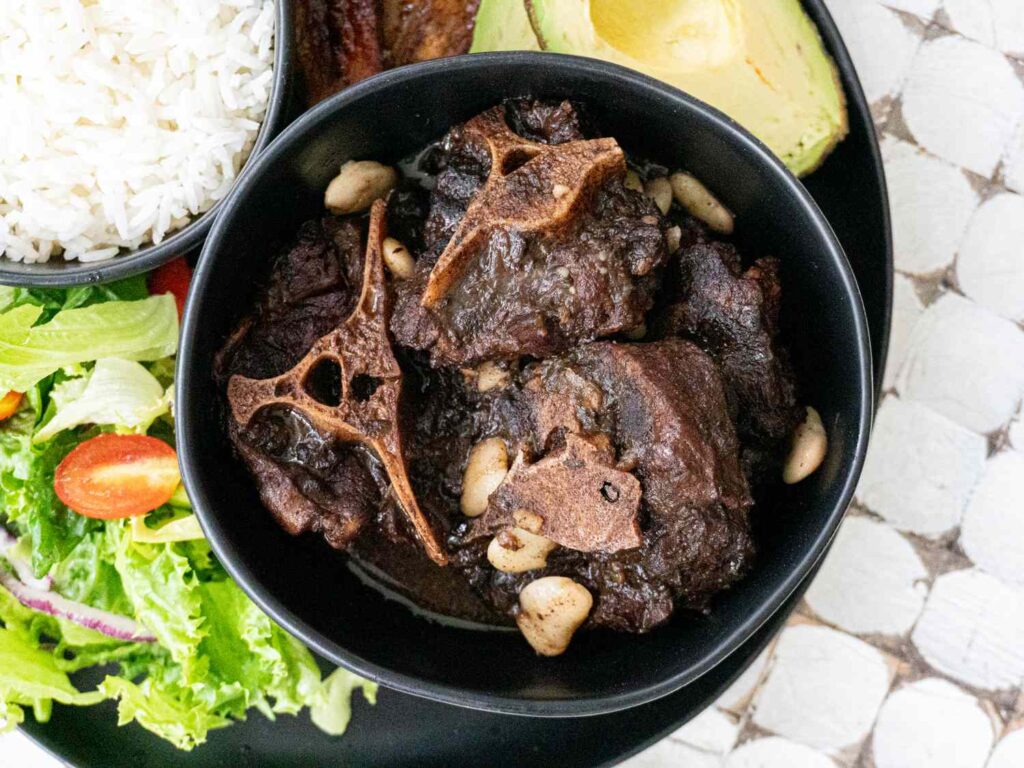
Another popular way to use this cut is by making this famed Jamaican oxtail recipe. Braised with spicy scotch bonnet peppers and butter beans, this offers a satisfying bite. With seasonings like Worcestershire sauce, garlic powder, and all-spice, these Jamaican oxtails promise a burst of flavour in your mouth.
4. Red Wine Braised Short Ribs
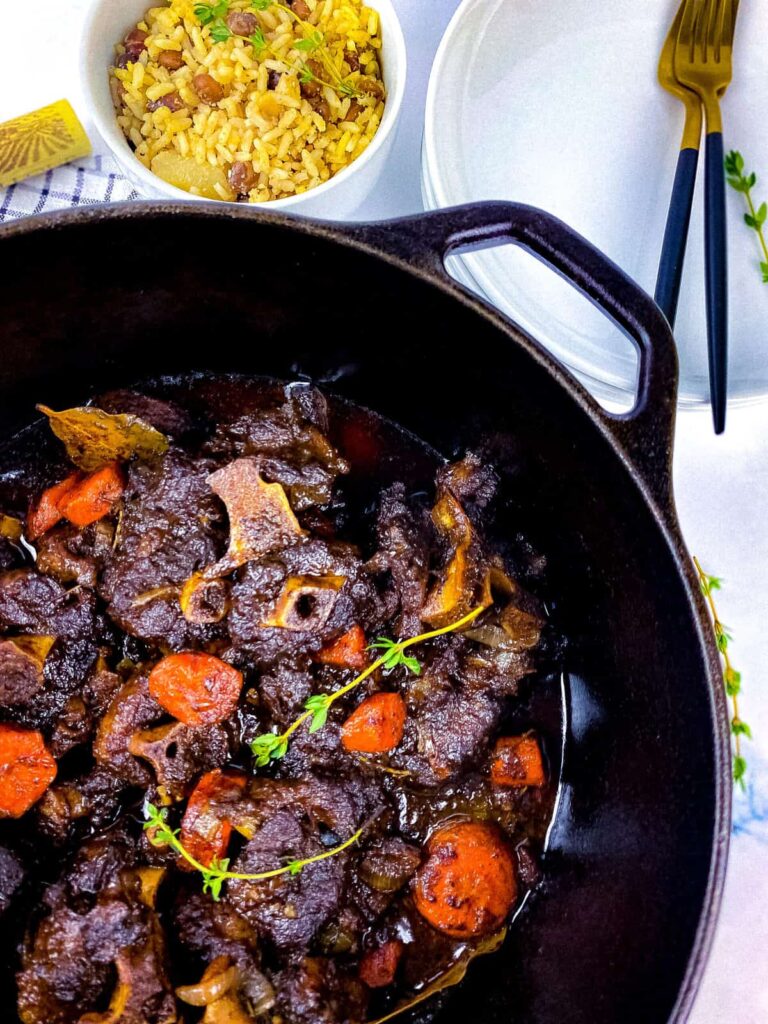
Add oxtail into a pot of beef short ribs for braising to intensify the meaty flavour of the dish. The pieces are drowned in a thick and flavorful tomato paste sauce. It isn’t too heavy, thanks to the bay leaf infused into the concoction.
5. Southern-Style Oxtail
The Southern oxtail recipe showcases smothered oxtails slowly cooked and tenderized in a savoury onion and garlic-flavoured gravy.
6. Hawaiian Oxtail Soup
The oxtail fat is trimmed in this Hawaiian soup, producing a broth that isn’t as thick as those previously mentioned. Simmered in water with dried orange peel, star anise, ginger, and salt, this special cut lends a meaty flavour to the dish. Bay leaves, cinnamon, and peppercorns are common add-ons.
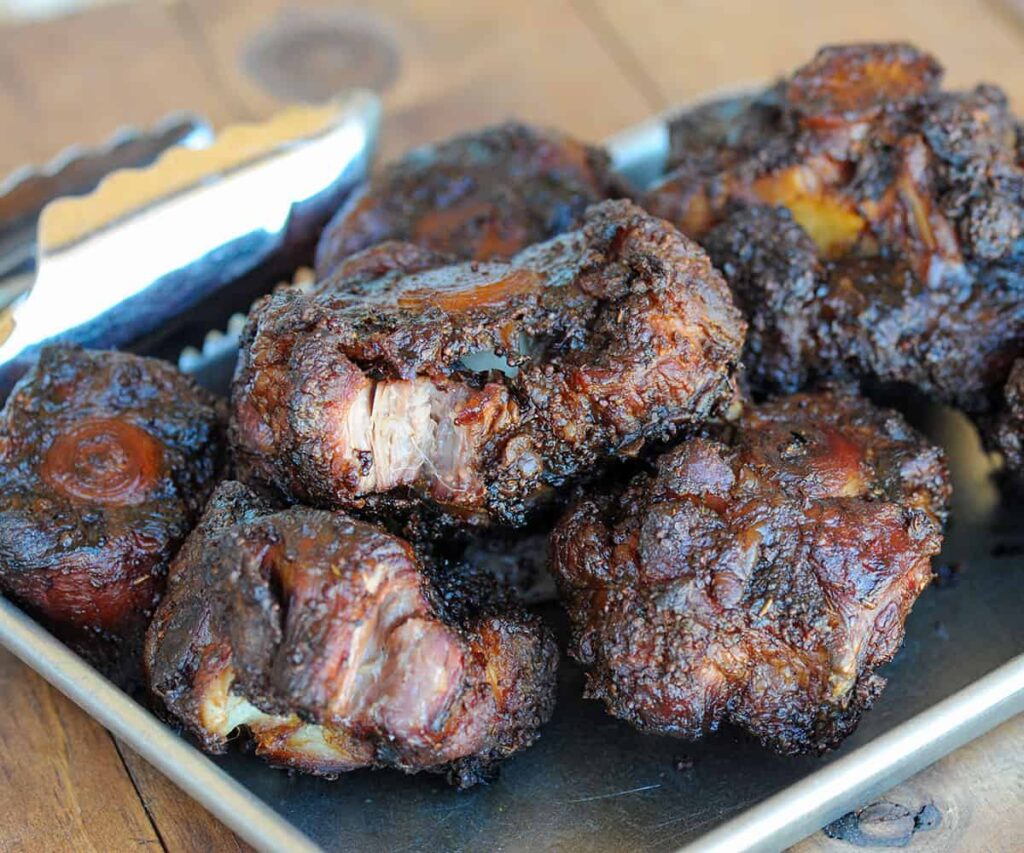
SEE: Saffron Rice Recipe
The benefit of eating Oxtail
1. Source of Essential Minerals
Oxtail is a good source of essential minerals like zinc, which plays a vital role in immune function, wound healing, and cellular metabolism. Additionally, it contains potassium, which is crucial for maintaining proper fluid balance, nerve function, and muscle contractions.
2. Healthy Fats
While oxtail contains some saturated fat, it also provides monounsaturated and polyunsaturated fats, considered heart-healthy fats. These fats can contribute to a balanced diet and support various bodily functions.
3. Bone Health
Oxtail contains bone, marrow, and cartilage, which can provide additional nutrients like calcium and phosphorus that contribute to bone health.
4. Flavour and Satiety
Oxtail’s rich, hearty flavour and tender texture make it a satisfying and comforting addition to meals. It can enhance the taste of soups, stews, and other dishes, making them more enjoyable and satiating.
5. Good Source of Iron
Oxtail is notably high in iron, a critical mineral that is essential for oxygen transport in the blood. Iron is a component of haemoglobin, the protein responsible for carrying oxygen from the lungs to other parts of the body. Adequate iron intake helps prevent iron-deficiency anaemia and supports overall energy production.
6. Rich in Collagen and Gelatin
Oxtail contains a significant amount of collagen and gelatin, which are beneficial for joint health and skin elasticity. Collagen is a structural protein that supports joint function and helps maintain the integrity of connective tissues. When oxtail is cooked slowly, collagen breaks down into gelatin, providing a rich and velvety texture to soups and stews.
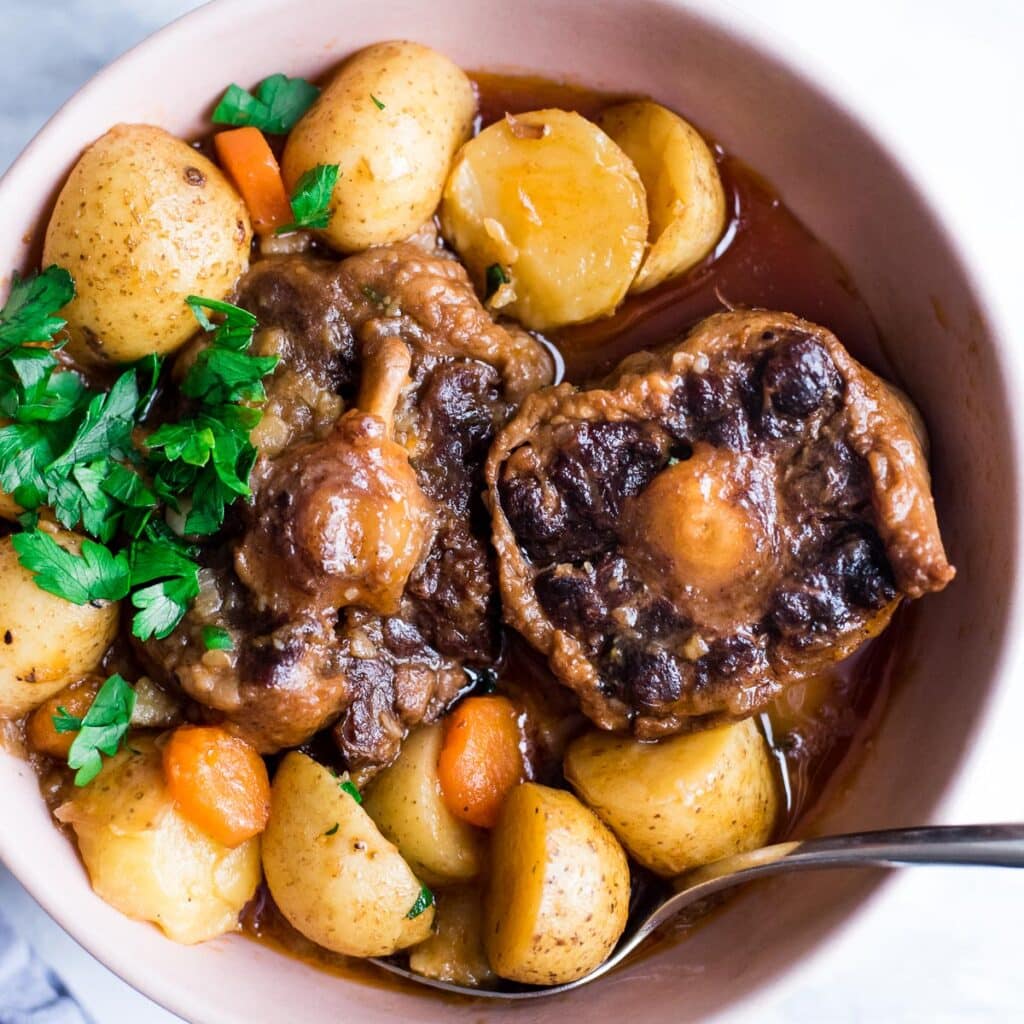
READ ALSO: Chicken Noodle Soup Recipe
How to Store Oxtail
Cool the oxtail to room temperature, transfer it to an airtight container, and store it in the fridge for up to four days. Reheat in a saucepan over medium heat.
1. Refrigeration
Oxtail should be kept in the refrigerator if you intend to use it within a few days. If the packaging is airtight, keep the oxtail in it. If it’s not, place it in a plastic bag that can be sealed, or tightly wrap it in aluminium foil or plastic wrap. Put the oxtail on the shelf or in the refrigerator’s meat drawer, which is the coldest.
2. Freezing
It is the greatest method to maintain the oxtail’s quality if you don’t want to use it right away. To avoid freezer burn and preserve the oxtail’s flavour and texture over a lengthy period of time, it must be packaged carefully.
- Wrap: Use aluminium foil or plastic wrap to individually wrap each piece of oxtail. This will lessen the chance of the pieces staying together while being frozen.
- Air-tight Container: Alternatively, you can put the individually wrapped pieces in a heavy-duty resealable plastic bag or an airtight container.
- Label: Don’t forget to include the date on the packaging’s label so you can monitor how long it has been stored.
3. Placement in the Freezer
Put the bagged or wrapped oxtail in the freezer. Use a freezer set to 0°F (-18°C) or lower for best results. If you have a deep freezer, place the oxtail there to maintain temperatures more consistently.
SEE: Sweet Delights: Irresistible Sugar Cookie Recipe
Conclusion
Oxtail stands as a testament to the art of transforming humble ingredients into culinary delights. From its ancient origins to its prominence in contemporary kitchens, oxtail’s rich history and unique flavours have captivated food enthusiasts worldwide.
Whether stewed, braised, or slow-cooked, this nutrient-dense cut of meat offers a savoury and satisfying experience that lingers long after the last bite. Its journey through time and diverse cuisines showcases the enduring appeal of this delectable delicacy.
Oxtail remains an enduring symbol of how simplicity and patience can yield unforgettable gastronomic experiences.
FAQs
What kind of meat is oxtails?
Oxtail is the tail of a cow. A long time ago, it came from the tail of an ox, but now it comes from the tail of a cow of either s3x. The tail is skinned and cut into sections. Each section has a tailbone with some marrow in the centre and a bony portion of meat surrounding the tail.
Why do people eat oxtails?
Beef Oxtail is a fat and collagen powerhouse.
Surprise, Beef Oxtail is a firm favourite amongst the Paleo Diet and Carnivore Diet communities for its satiating energy.
Is oxtail good for your health?
Oxtail is rich in Collagen, a vital protein for our body’s growth and repair. Oxtail is high in fat, so an ideal energy source for a Ketogenic, Paleo, or Carnivore Diet. With over 70% fat, Oxtail is Ideal for anyone on a high-fat / low-carb or no-carb diet. Oxtail must be slow-cooked to break down the connective tissue.
Why is oxtail expensive?
Oxtail meat is considered a delicacy. There’s only one tail per cow, and so a limited amount is available. Combine this with the low yield of meat an oxtail provides, coupled with high demand, and boom. You’ve got an expensive product



